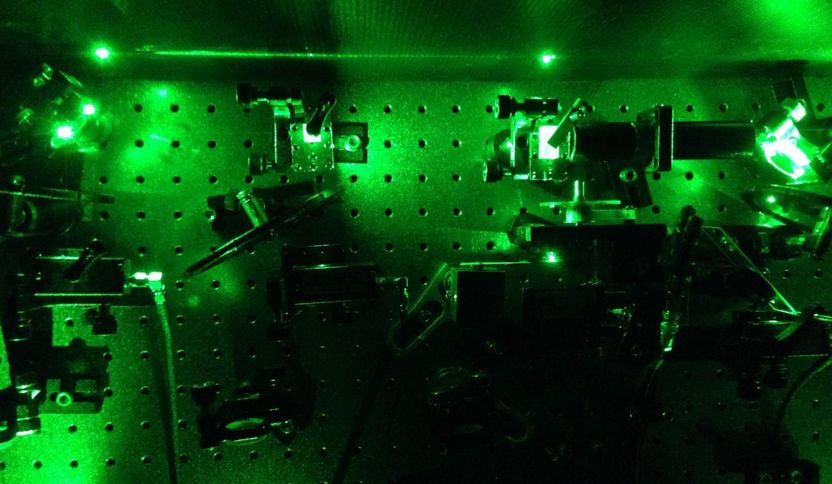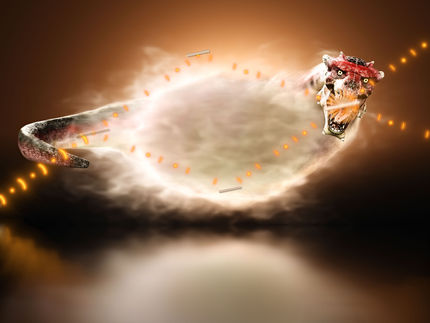Scientists 'squeeze' light one particle at a time
A team of scientists have measured a bizarre effect in quantum physics
Advertisement
A team of scientists has successfully measured particles of light being "squeezed", in an experiment that had been written off in physics textbooks as impossible to observe.

An image from an experiment in the quantum optics laboratory in Cambridge. Laser light was used to excite individual tiny, artificially constructed atoms known as quantum dots, to create "squeezed" single photons.
Mete Atature
Squeezing is a strange phenomenon of quantum physics. It creates a very specific form of light which is "low-noise" and is potentially useful in technology designed to pick up faint signals, such as the detection of gravitational waves.
The standard approach to squeezing light involves firing an intense laser beam at a material, usually a non-linear crystal, which produces the desired effect.
A team of physicists report that they have successfully demonstrated the squeezing of individual light particles, or photons, using an artificially constructed atom, known as a semiconductor quantum dot. Thanks to the enhanced optical properties of this system and the technique used to make the measurements, they were able to observe the light as it was scattered, and proved that it had indeed been squeezed.
Professor Mete Atature, a Fellow of St John's College at the University of Cambridge, who led the research, said: "We managed to do it because we now have artificial atoms with optical properties that are superior to natural atoms. That meant we were able to reach the necessary conditions to observe this fundamental property of photons and prove that this odd phenomenon of squeezing really exists at the level of a single photon. It's a very bizarre effect that goes completely against our senses and expectations about what photons should do."
It begins with the fact that wherever there are light particles, there are also associated electromagnetic fluctuations. This is a sort of static which scientists refer to as "noise". Typically, the more intense light gets, the higher the noise. Dim the light, and the noise goes down.
But strangely, at a very fine quantum level, the picture changes. Even in a situation where there is no light, electromagnetic noise still exists. These are called vacuum fluctuations. While classical physics tells us that in the absence of a light source we will be in perfect darkness, quantum mechanics tells us that there is always some of this ambient fluctuation.
Importantly, these vacuum fluctuations are always present and provide a base limit to the noise of a light field. Even lasers, the most perfect light source known, carry this level of fluctuating noise.
This is when things get stranger still, however, because, in the right quantum conditions, that base limit of noise can be lowered even further. This lower-than-nothing, or lower-than-vacuum, state is what physicists call squeezing.
In the Cambridge experiment, the researchers achieved this by shining a faint laser beam on to their artificial atom, the quantum dot. This excited the quantum dot and led to the emission of a stream of individual photons. Although normally, the noise associated with this photonic activity is greater than a vacuum state, when the dot was only excited weakly the noise associated with the light field actually dropped, becoming less than the supposed baseline of vacuum fluctuations.
Explaining why this happens involves some highly complex quantum physics. At its core, however, is a rule known as Heisenberg's uncertainty principle.
In the Cambridge experiment, the researchers used that rule to their advantage, creating a tradeoff between what could be measured, and what could not. By scattering faint laser light from the quantum dot, the noise of part of the electromagnetic field was reduced to an extremely precise and low level, below the standard baseline of vacuum fluctuations. This was done at the expense of making other parts of the electromagnetic field less measurable, meaning that it became possible to create a level of noise that was lower-than-nothing, in keeping with Heisenberg's uncertainty principle, and hence the laws of quantum physics.
Plotting the uncertainty with which fluctuations in the electromagnetic field could be measured on a graph creates a shape where the uncertainty of one part has been reduced, while the other has been extended. This creates a squashed-looking, or "squeezed" shape, hence the term, "squeezing" light.

































































